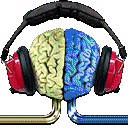
...and
'George Bush is like crusty potato'
James Wannerton, president of the UK Synaesthesia Association, explains how the condition which "mixes the senses" affects his life. He is speaking at a conference in Edinburgh where scientists and others with the condition are discussing the phenomenon.
Wannerton experiences a rare form of synesthesia known as lexical-gustatory synesthesia, in which spoken and written words elicit specific taste sensations that remain constant (Ward & Simner, 2003).
He continues describing his experience in the BBC article:
For as long as I can remember, words, word sounds, musical instruments and certain ambient noises have produced involuntary bursts of taste on my tongue.Texture and temperature also feature in this experience which is with me 24 hours a day. My dreams also contain tastes, and I am unable to turn it off.Although predominant during my formative years, I never considered these invasive sensations to be abnormal. Tasting words seemed as natural as breathing. As I got older and more involved in the wider world, I found my word/taste associations having an increasing effect in my everyday life, subtly dictating the nature and course of my friendships, personal relationships, my education, my career, where I live, what I wear, what I read, the make and colour of car that I drive. The list is endless.. . .
Whenever I see a picture of Tony Blair I instantly get the taste of desiccated coconut. Gordon Brown leaves me with a very strong taste of dirt and Marmite, so he shouldn't count on getting my vote. George Bush gives me a taste similar to the crusty potato bit on top of a cottage pie.
Why does this occur? Lexical-gustatory synesthesia has not yet been studied from a neurophysiological perspective. A more common form of synesthesia is grapheme-color synesthesia, where numbers and letters are consistently associated with specific colors (Ward et al., 2005). What are the neural mechanisms of such percepts? A recent study (Rouw & Scholte, 2007) used diffusion tensor imaging, a magnetic resonance imaging method that provides images of white matter tracts, to provide suggestive evidence of increased connectivity in the inferior temporal lobe regions involved in processing color and letter/word stimuli.1
Footnote
1 Although the increase in anisotropy, indicative of greater connectivity, extended to multiple brain areas [explained by hand-waving].
References
Rouw R, Scholte HS. (2007). Increased structural connectivity in grapheme-color synesthesia. Nature Neuroscience, 10(6), 792-797. DOI: 10.1038/nn1906
Ward J, Simner J. (2003). Lexical-gustatory synaesthesia: linguistic and conceptual factors. Cognition 89:237-61.
Ward J, Simner J, Auyeung V. (2005). A comparison of lexical-gustatory and grapheme-colour synaesthesia. Cognitive Neuropsychology 22:28-41.

James gets a taste of Marmite
when he sees Gordon Brown
when he sees Gordon Brown












